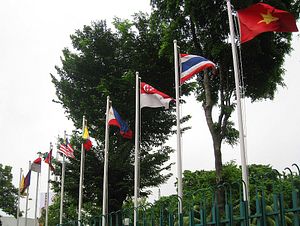The world’s dirtiest fossil fuel is in decline from the United States to western Europe. But in Southeast Asia coal has found one of its final frontiers: last year it was the only region where coal’s share of power generation grew. Yet the growing urgency of the climate crisis and increasingly affordable renewable power could help catalyze a regional shift away from the fuel towards cleaner energy.
Coal is the single biggest contributor to global warming. In 2018, one third of all carbon dioxide emissions came from burning it, said the International Energy Agency. Ending the use of coal-fired electricity is therefore critical to limit the rise in global heating to 1.5C and avoid catastrophic environmental breakdown. It’s why this week the UN Secretary General reiterated his appeal to world leaders that no new coal plants should be built after 2020.
But Southeast Asia, on paper at least, has other plans. Indonesia looks set to have the third-largest coal-fired power capacity of new plants under development after China and India. Vietnam, where the coal fleet has grown faster than in almost any other country, has the world’s fourth-largest pipeline for new coal. The fuel has long been viewed as the cheapest option to fuel a surging demand for electricity in Southeast Asia’s fast-growing economies. When it comes to renewable energy, ASEAN has been labelled the “worst-performing region” as renewables are typically dismissed as uncompetitive.
But change might be afoot. “It’s an absolute pivot point for renewables in Southeast Asia,” Tim Buckley, director of energy finance studies at the Institute for Energy Economics and Financial Analysis, told The Diplomat. While the region “has been a laggard” on renewable energy he points to game-changing recent developments. “The finances are shifting to green globally. Vietnam, the Philippines, Malaysia and Thailand will all pivot over the next two years.” Vietnam, for instance, has seen a surge in solar power development in the last year alone.
“No-one forecast Vietnam can do that. That’s how quickly you can pivot markets,” said Buckley. Earlier this month an auction for a solar power project in Cambodia saw the lowest power purchase tariff for solar so far in Southeast Asia. The Asian Development Bank, which supports the scheme, described it as “a new era for renewable energy development in Cambodia and the region”.
In a survey of regional leaders last year, media platform Eco-Business found “the ever-increasing risk of stranded fossil fuel assets” was another factor that would drive Southeast Asia’s transition to a greener economy. A big sign of the shifting financial backing for coal regionally came in April as three top Singapore banks said they would stop financing new coal-fired power plants. And in a June meet of Asian coal leaders in Indonesia, they talked of the difficulties of securing finances for projects. Some experts believe that the majority of proposed coal plants won’t emerge.
Yet it’s still a mammoth battle to end coal’s dominance. China, Japan and South Korea are filling the funding gap to finance new coal plants in the region even as other sources dry up. In August, environmental group Greenpeace highlighted the “deadly double standard” in a report about Japan’s financing of overseas coal-fired plants creating “air pollution at levels that would not be accepted” domestically. And a WWF study also published last month found that 91 percent of ASEAN banks still finance new coal-fired plants.
The spread of “clean coal” propaganda has proven to be another obstacle in developing actual clean energy in the region (a debate also playing out in Australia as it ramps up coal production at an alarming rate to “fuel a proposed new wave of power stations in Asia” as described here). “There is no such thing as clean coal,” said Buckley. “It’s the coal industry’s PR stunt.”
But it’s proving a handy justification for governments unwilling to abandon the fuel. In Indonesia, the world’s largest exporter of thermal coal, the idea of “clean coal is misleadingly projected as a mitigation step in fighting climate change, hindering the development of renewable energy,” said Hindun Mulaika, regional climate and energy coordinator for Greenpeace in Southeast Asia. The government should instead be working on policies to drive down the cost of renewables, strengthen regulations against emissions and remove fossil fuel subsidies, she told The Diplomat.
Anti-coal sentiment has been rising across the region. With growing calls for alternative energy from Jakarta to Hanoi, governments can no longer afford to ignore them. It’s a “tipping point” in Southeast Asia, said Justin Guay, director for global climate strategy at The Sunrise Project, an environmental group. “It’s the last major region on earth where we are seeing the transformation” away from coal and “it’s a question of when not if.”
“In many ways Southeast Asia reminds me of where India was five years ago,” he added. “They built a significant number of coal plants, but now they’ve got stranded assets. It’s a big problem. Southeast Asia has the opportunity to avoid that.”
The battle to stop countries digging and burning coal is at the core of the battle against climate disaster. Southeast Asia’s governments are at a unique crossroads. For a more resilient future for the region and the world, the hope is that they will abandon coal.
Editor’s Note: This is the second of a three-part series exploring critical battlegrounds in Southeast Asia’s fight against the climate crisis. The final part will be published later this month.

































